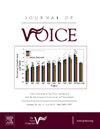伊林兹人和其他民间叫声高亢而响亮。我们能学到什么吗?
IF 2.5
4区 医学
Q1 AUDIOLOGY & SPEECH-LANGUAGE PATHOLOGY
引用次数: 0
摘要
简介在各种文化中,都有与民间传统相关的声音和呐喊。所有这些叫声都是一口气发出的,频率高,声音大。因此,它们在很远的地方都能听到,并能穿过其他声音表达或乐器产生的其他声音:这项工作的目的是对其中一些民歌进行声学分析,并研究所有民歌的共同要素:在这项研究中,对 Irrintzi、Aturuxo、Tzagrit、ululation Darfur 和 Kurava 的叫声进行了描述性声学频谱分析,并从各种声学参数的角度对分析结果进行了定量比较,从频谱特征和叫声听起来的方式的角度对分析结果进行了定性比较:结果:所有的叫声都含有高频率。啼哭声的频谱图显示,这些啼哭声有一个共同的模式:较低的初始频率迅速上升(攻击),然后在整个发射的稳定阶段(主体)保持稳定,最后频率下降(结束或尾声)。本体是最长的阶段:对五种民间传统声音的初步研究为我们提供了丰富的声学和文化发现。现在需要进行更广泛的研究,以确定我们报告的特征是否与其他叫声相同,寻找其他相似之处,并深入探讨其含义、寓意和可能的应用。深入了解传统哭声的发出机制,可以为声带劳损(肌肉紧张性发音障碍、声带小结等)导致的发音障碍患者的嗓音再教育、改善嗓音质量和提高发声效率提供工具。本文章由计算机程序翻译,如有差异,请以英文原文为准。
The Irrintzi and Other Folk Cries High Pich and Loud Emission. Can We Learn Something?
Introduction
In various cultures there are vocal sounds and cries associated with the folk tradition.
All these cries are emitted in a single breath, have a high frequency and are loud. They are consequently audible over long distances and cut through other vocal expressions or other sounds generated by instruments.
Objectives
The objective of this work is to acoustically analyze some of these folkloric cries and study elements common to all of them.
Methods
In this study, Irrintzi, Aturuxo, Tzagrit, ululation Darfur and Kurava cries were subjected to descriptive acoustic spectrographic analysis, and the resulting descriptions were compared both quantitatively, in terms of various acoustic parameters, and qualitatively, in terms of spectrographic characteristics and the way the cries sound.
Results
All of the cries contained high frequencies. Spectrograms of the cries revealed that they had a common pattern: a lower initial frequency ascends rapidly (the attack) and is then maintained throughout a stable phase of the emission (the body) before a final drop in frequency (the ending or coda). The body is the longest phase.
Conclusions
This initial study of five sounds of folk tradition has opened up a wealth of acoustic and cultural discoveries. Broader studies are now needed to determine if the characteristics we have reported are common to other cries, to look for other similarities, and to delve into meanings, implications and possible applications.
In-depth understanding of the mechanism of emission of traditional cries could provide tools for voice re-education in patients with dysphonia due to vocal strain (muscle tension dysphonia, vocal nodules, etc.), for improving voice quality, and for increasing the efficiency of vocal performance.
求助全文
通过发布文献求助,成功后即可免费获取论文全文。
去求助
来源期刊

Journal of Voice
医学-耳鼻喉科学
CiteScore
4.00
自引率
13.60%
发文量
395
审稿时长
59 days
期刊介绍:
The Journal of Voice is widely regarded as the world''s premiere journal for voice medicine and research. This peer-reviewed publication is listed in Index Medicus and is indexed by the Institute for Scientific Information. The journal contains articles written by experts throughout the world on all topics in voice sciences, voice medicine and surgery, and speech-language pathologists'' management of voice-related problems. The journal includes clinical articles, clinical research, and laboratory research. Members of the Foundation receive the journal as a benefit of membership.
 求助内容:
求助内容: 应助结果提醒方式:
应助结果提醒方式:


